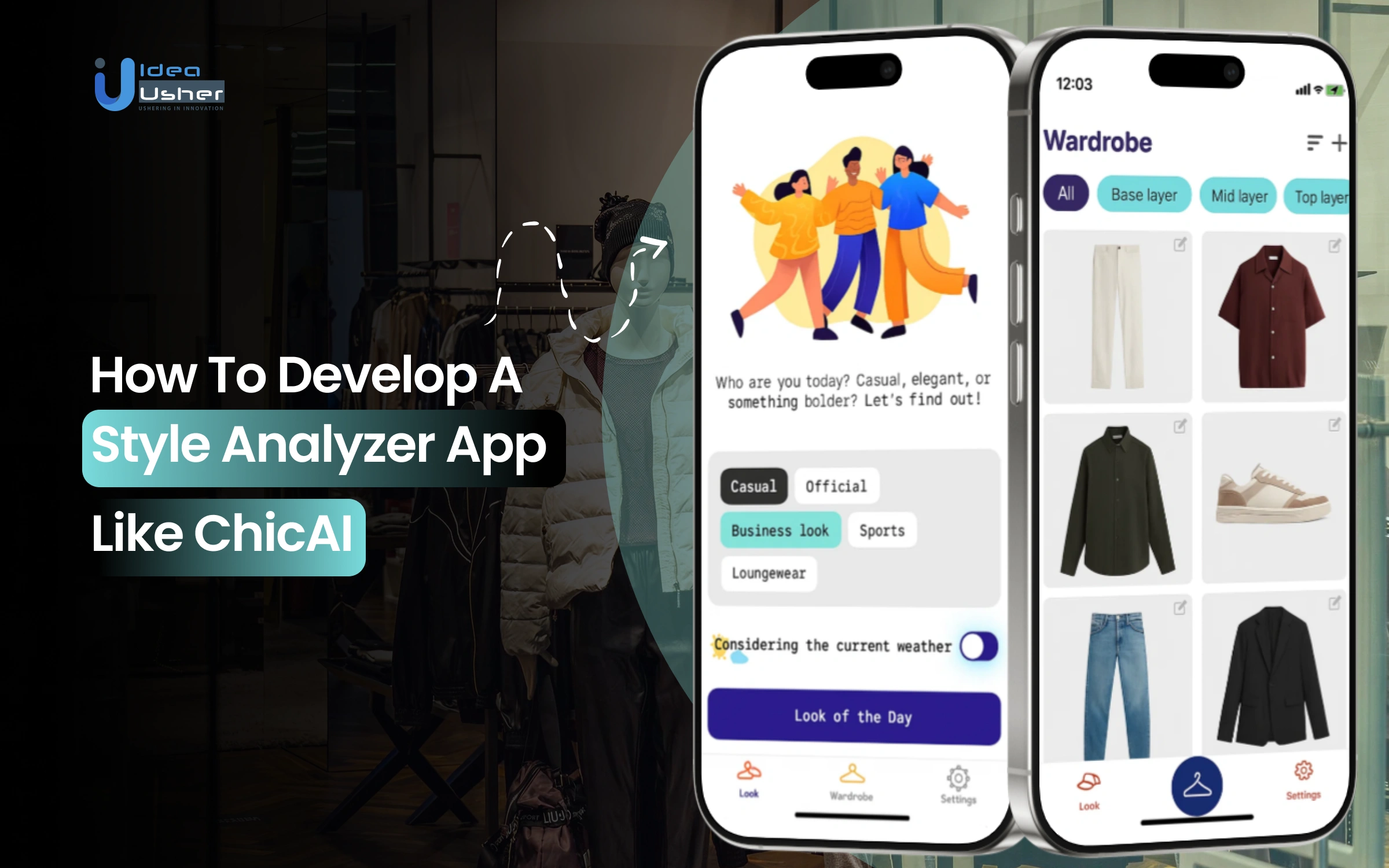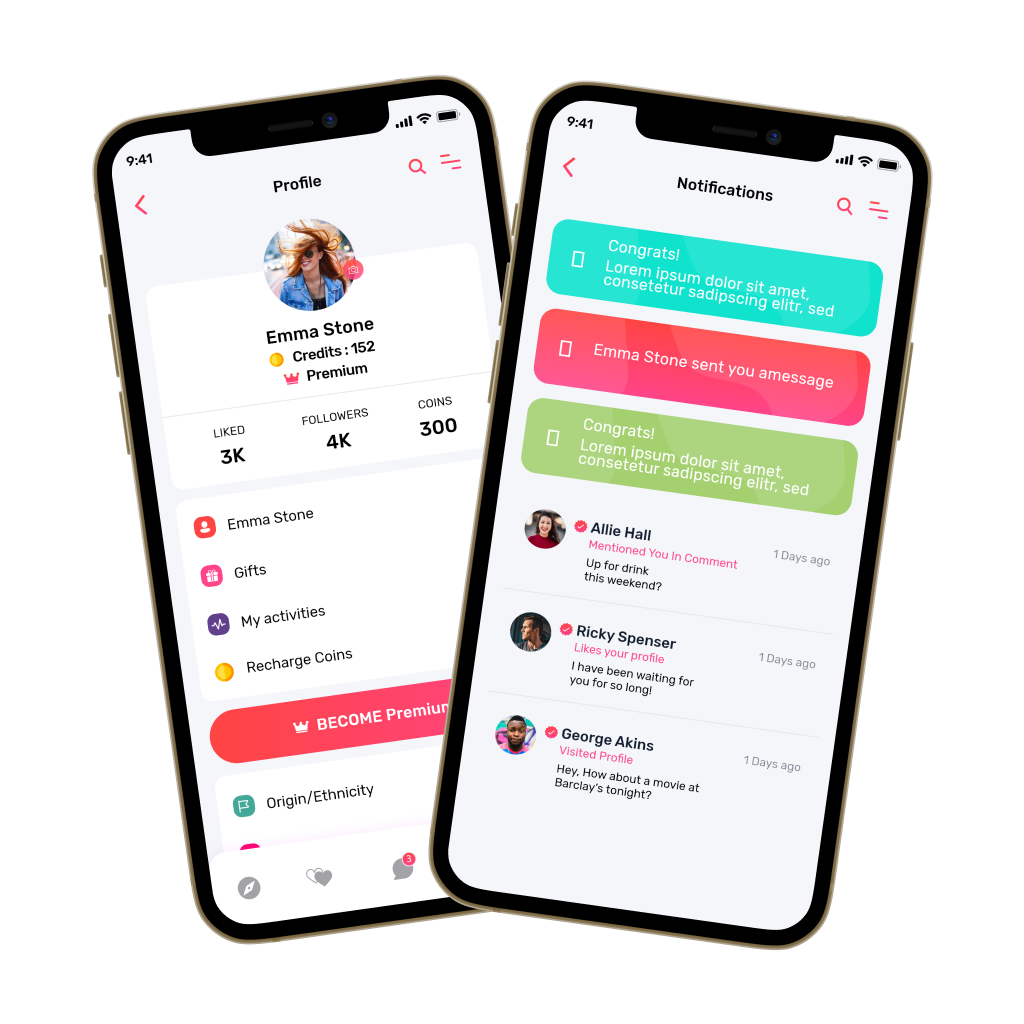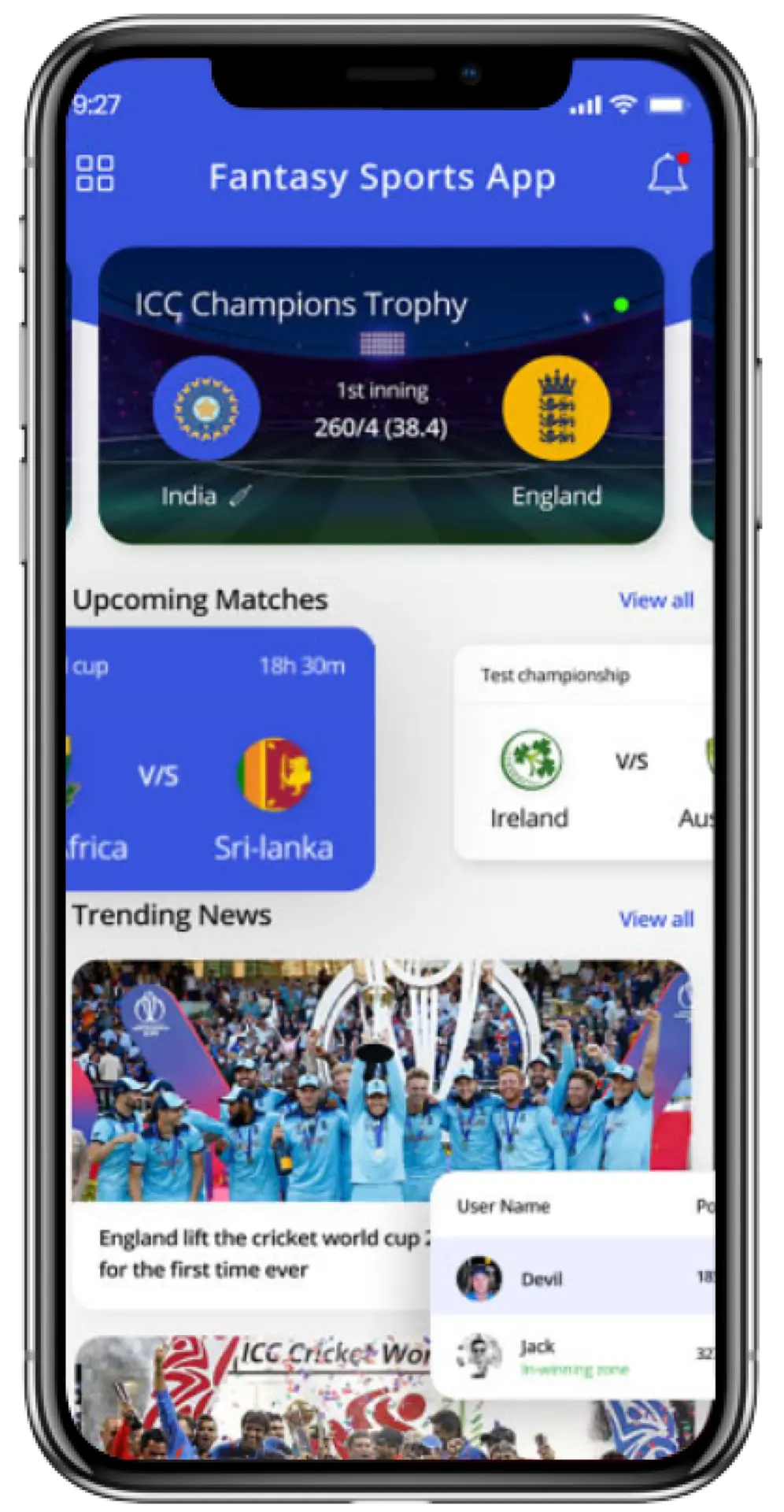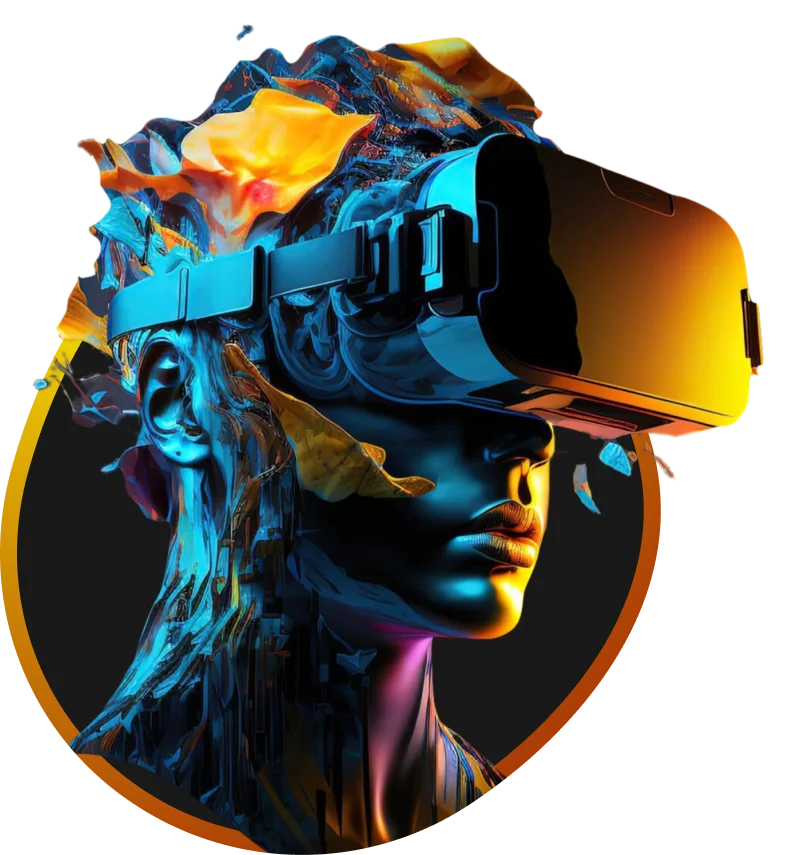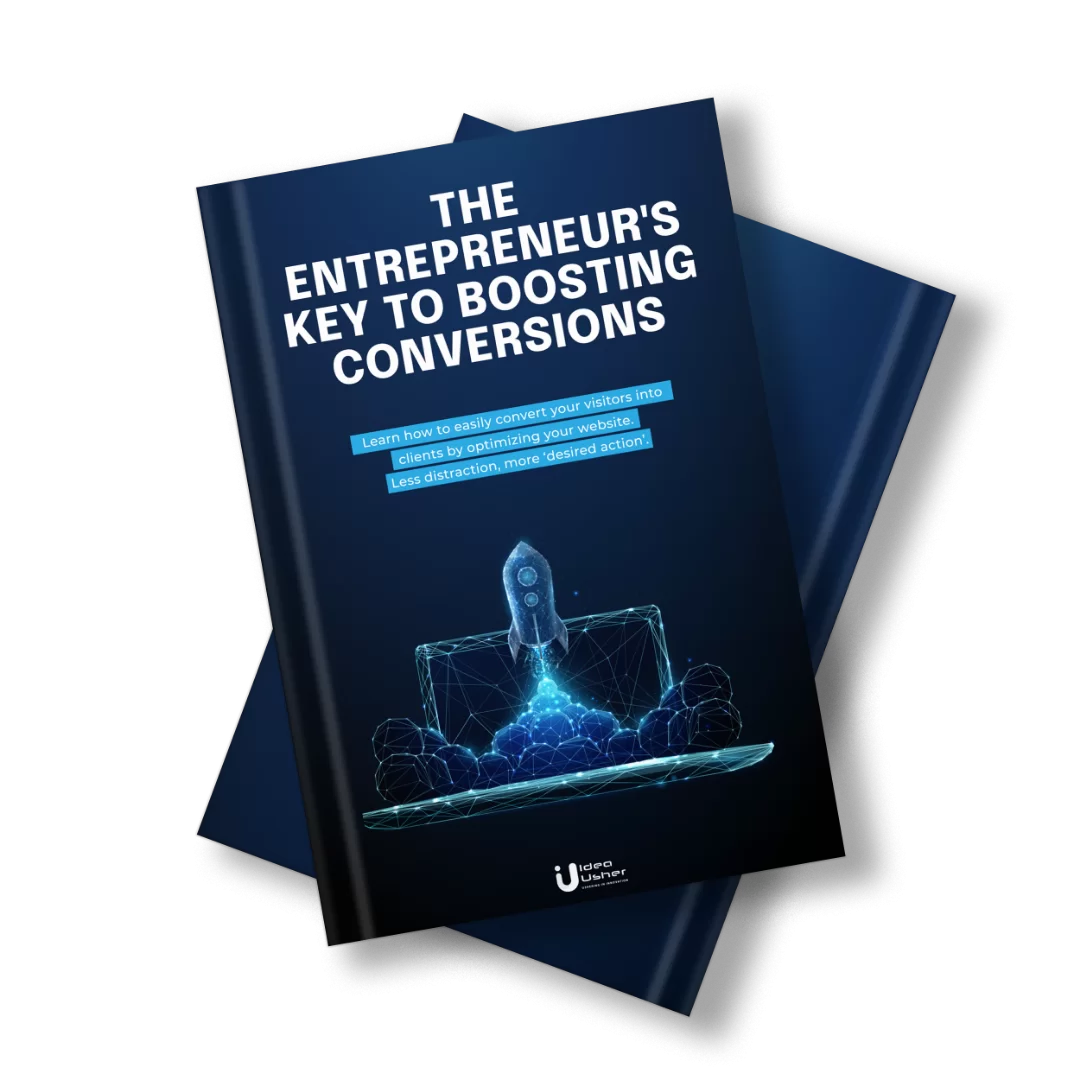Fashion is more expressive and fast-moving than ever, but it can be hard to know what really suits you. With so many outfit choices, changing trends, and the impact of social media, many people find it tough to define their own style. A Style Analyzer App like ChicAI can help by using AI to look at your outfits, learn your preferences, and offer personalized styling tips that make fashion feel easy.
This kind of innovation brings together advanced technologies like computer vision, machine learning, and data-driven personalization. These tools work together to interpret fabrics, colors, and body proportions with impressive accuracy. Here, technology meets taste, making everyday styling choices smarter and more personalized.
In this blog, we’ll explain about apps like ChicAI development, features, design tips, and development costs to help businesses lead the way in personalized fashion. Backed by deep expertise in AI-driven app innovation, IdeaUsher empowers enterprises to transform creative fashion-tech ideas into cutting-edge digital styling experiences.

What is a Style Analyzer App, ChicAI?
ChicAI is an AI-powered style analyzer and fashion recommendation platform that helps users make smarter wardrobe and styling decisions. By combining artificial intelligence, computer vision, and machine learning, it analyzes users’ wardrobes, color palettes, and fashion preferences to create personalized outfit suggestions.
The app scans your clothing images to build a digital wardrobe, spot color patterns, and suggest outfits that fit your body, lifestyle, and current trends. It goes beyond basic styling help. ChicAI acts as your personal fashion advisor, adjusting to your taste and keeping up with changing styles.
Business Model
ChicAI is an AI-powered personal styling platform offering personalized, sustainable fashion advice through AI and expert insights. It provides outfit recommendations, style consultations, and wardrobe management.
Key Components of ChicAI’s Business Model:
- AI-Driven Styling: Uses machine learning to analyze user preferences, body type, and lifestyle to create tailored outfit suggestions.
- Sustainability Focus: Encourages mindful consumption by promoting outfit re-use and sustainable shopping habits.
- Digital Platform: Operates primarily through its website and virtual interface, enabling easy bookings and online interactions.
- Target Audience: Focused on fashion-conscious individuals, professionals, and eco-minded shoppers looking for convenience and confidence in styling.
- Human + AI Collaboration: Combines technology with professional stylists to deliver a premium and personalized experience.
Revenue Model
ChicAI’s revenue model is built around direct service fees, digital consultations, and potential affiliate income, allowing it to monetize both personalized styling and curated shopping experiences.
Key Revenue Streams:
- Consultation Fees: Charge users for services such as Virtual Wardrobe Refreshes and AI Style Consultations.
- Workshops & Premium Experiences: Earns from sustainable fashion workshops and advanced style sessions.
- Subscription Plans: Offers recurring monthly memberships for ongoing style support and exclusive content.
- Affiliate Commissions: Generates income through partnerships with fashion retailers, earning a percentage on purchases made via ChicAI recommendations.
- Recurring Revenue Opportunities: Focuses on shifting from one-time services to ongoing subscriptions for scalability and stability.
How Style Analyzer Apps Are Redefining the Fashion Experience?
AI-powered style apps like ChicAI transform fashion by blending creativity, technology, and personalization. They facilitate smarter, faster style choices, replacing intuition or trends with intelligent, adaptive assistants.
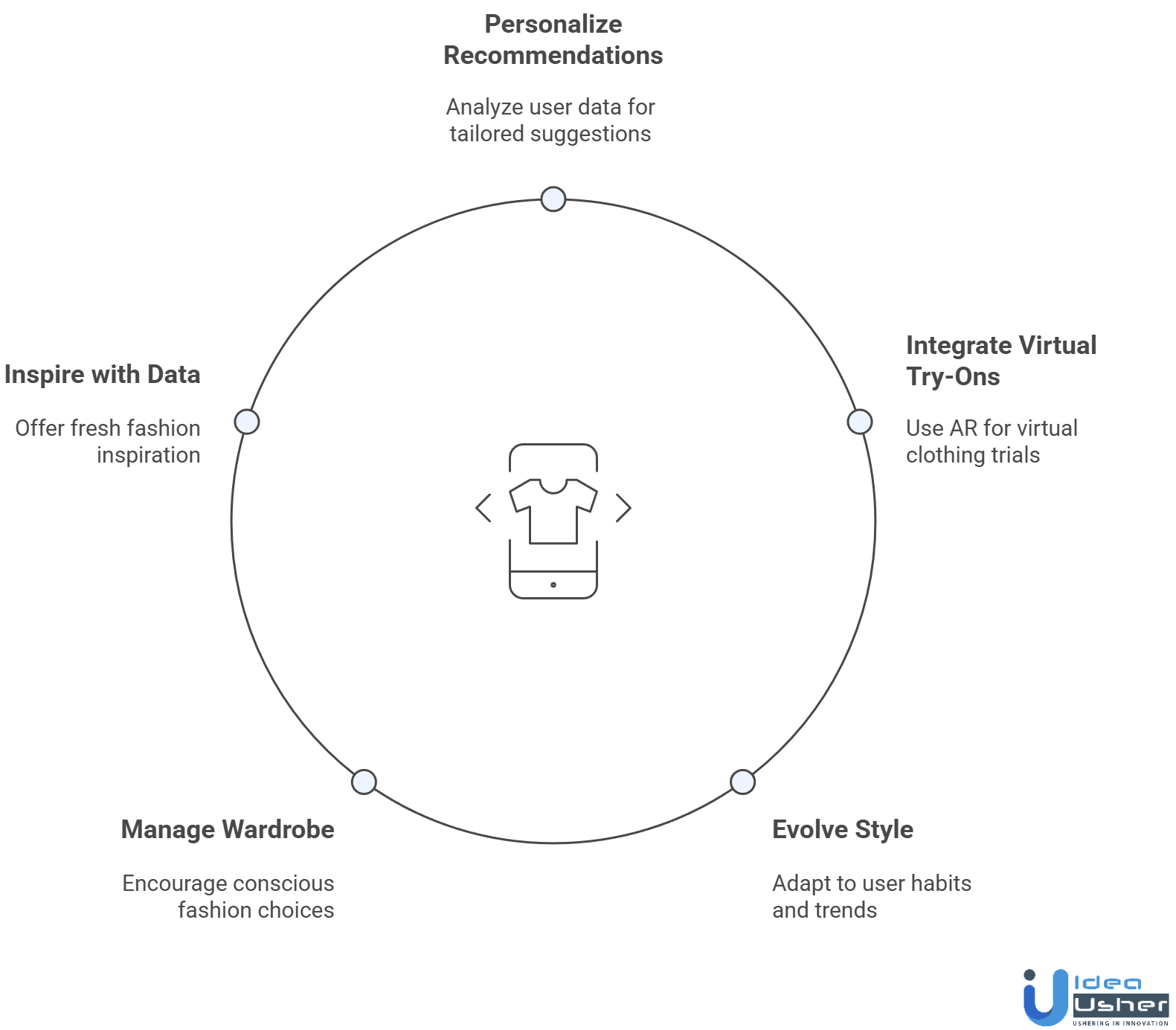
1. Hyper-Personalized Fashion Curation
These apps analyze user behavior, wardrobe data, and body measurements to deliver outfit recommendations that feel uniquely “you.” Every suggestion becomes more accurate over time, mirroring your evolving taste and lifestyle.
2. Seamless Integration of Virtual and Real Worlds
AR-based virtual try-ons let users see how clothes will look and fit before they buy, which takes away the guesswork and helps lower return rates. Blending digital and physical fashion makes shopping feel more confident.
3. AI-Powered Style Evolution
Style analyzers do more than just make recommendations. They look at your habits to find the styles that suit you best and suggest new trends that fit your preferences. This helps you develop your own sense of style.
4. Smarter Wardrobe Management
These apps encourage conscious fashion choices by spotlighting how to restyle existing clothes and avoid unnecessary shopping. Users can see the environmental and financial benefits of maximizing their current wardrobe.
5. Data-Driven Fashion Inspiration
AI analyzes global fashion data, influencer looks, and trend forecasts to offer fresh inspiration. This democratizes style access, allowing every user to explore trends once reserved for stylists or celebrities.

Why Anyone Should Invest in the Style Analyzer App?
The styling App Market size was valued at USD 2.6 Billion in 2023 and is projected to reach USD 8.4 Billion by 2030, growing at a CAGR of 30.98% during the forecast period 2024-2030. The market growth is driven by the rising adoption of AI-powered personalization tools and increasing consumer demand for virtual styling and fashion assistance.
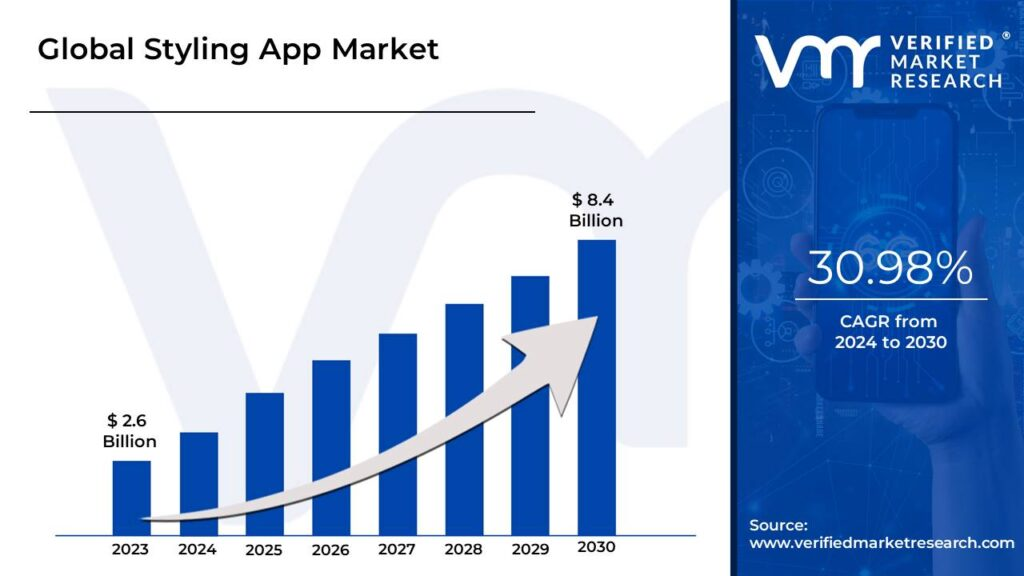
Phia, launched in April 2025, is an AI shopping agent with $8 million in seed funding from Kleiner Perkins, supported by Hailey Bieber, Kris Jenner, and Sheryl Sandberg. It offers a user-friendly iOS app and browser extension, helping consumers compare prices and track real-time discounts.
Alta is an AI-powered personal shopping app that raised $11 million in June 2025. Menlo Ventures led the round, with Aglaé Ventures, Tony Xu, and Karlie Kloss also participating. The app creates custom outfits and virtual try-ons based on each user’s wardrobe, lifestyle, budget, occasion, and local weather, which has helped it gain popularity.
Gensmo raised over $60 million in seed funding, aiming to bring real AI innovation to the fashion e-commerce world. The company focuses on integrating AI to enhance the online shopping experience.
Daydream secured $50 million in seed financing co-led by Forerunner Ventures and Index Ventures. The platform operates a conversational fashion shopping interface using AI search, offering a personalized shopping experience.
Investments in the style analyzer app reflect increasing trust in AI’s ability to change the fashion industry. These platforms improve the shopping experience with personalized styling and are driving fast growth in AI for fashion. As consumer preferences shift, AI is likely to become a key part of the industry’s future.
How Style Analyzer Apps Create Real Value for Users?
Style analyzer apps do more than improve appearance. They simplify outfit choices, boost confidence, and reshape fashion connections. By combining AI insights with personal tastes, these tools provide both practical and meaningful benefits.
1. Saves Time in Daily Outfit Decisions
With automated wardrobe organization and AI-based outfit suggestions, users spend less time thinking about what to wear. The app intelligently recommends looks based on weather, occasion, and personal style, turning dressing up into a quick, effortless process.
2. Maximizes Wardrobe Utilization
Many people wear only a fraction of their wardrobe. Style analyzer apps analyze existing clothing to suggest new combinations, ensuring users make the most of what they already own and shop more mindfully.
3. Personalized Styling Experience
AI learns from user feedback, preferences, and mood to offer style suggestions that truly reflect individual taste. This makes fashion more inclusive and accessible, even for those without a natural flair for styling.
4. Boosts Shopping Confidence
By integrating smart shopping assistants and virtual try-on tools, users can visualize how an outfit might look before buying. This reduces return rates and helps shoppers make better purchasing decisions.
5. Encourages Sustainable Fashion Choices
Through data-driven insights, the app discourages impulsive purchases and promotes reusing or restyling existing pieces. Some even suggest sustainable brands, contributing to more eco-conscious consumption.
6. Builds a Digital Fashion Identity
Users can document and evolve their personal style over time, tracking how their fashion preferences shift. This digital style profile helps them stay consistent and confident in their unique aesthetic.
Key Features of a Style Analyzer App like ChicAI
AI-powered style analyzer app like ChicAI simplify fashion decisions, help users organize wardrobes, and provide personalized styling insights. Below are the core features:
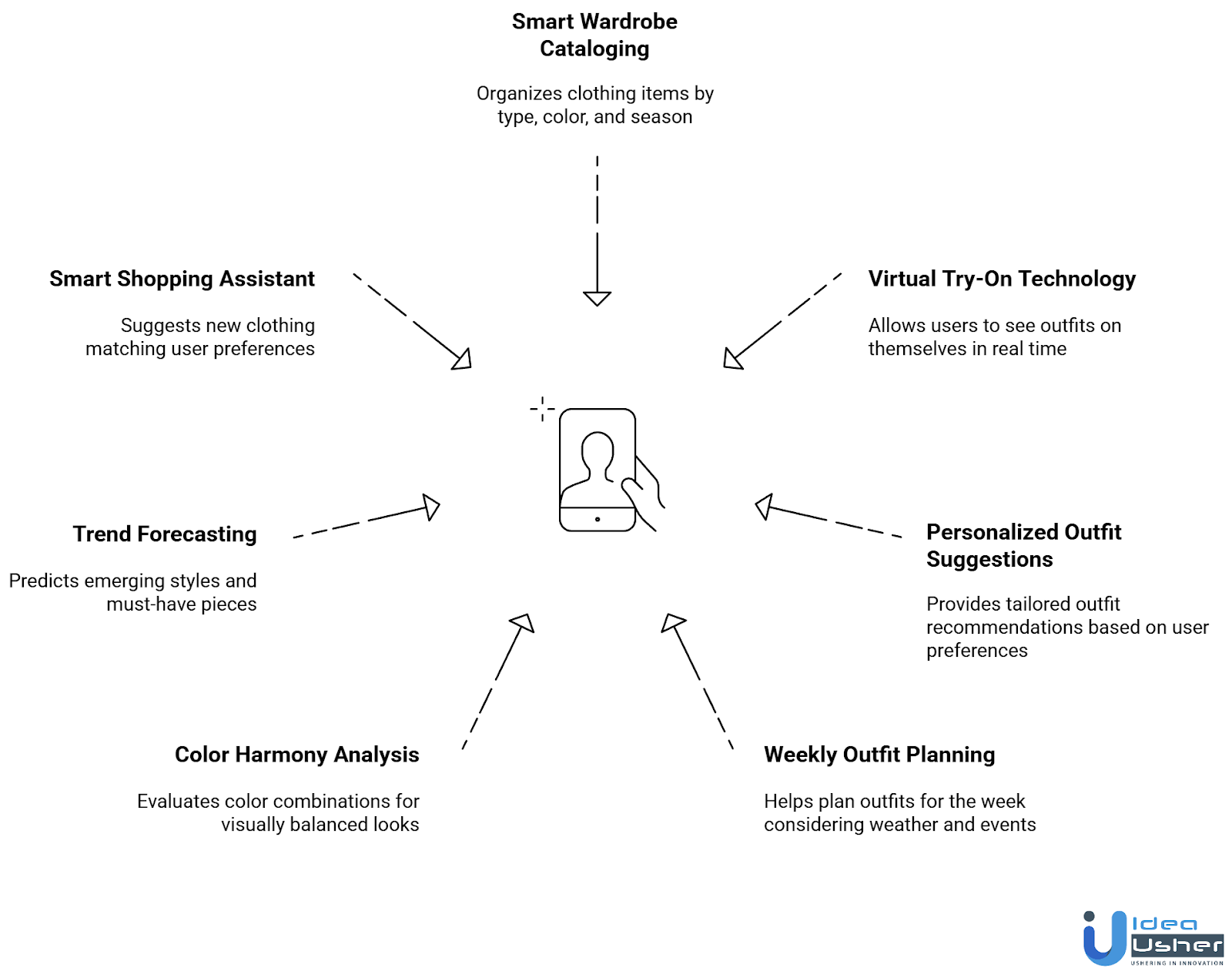
1. Smart Wardrobe Cataloging
Users can digitize their entire wardrobe by uploading images of clothing items. The AI automatically categorizes each piece by type, color, pattern, and season, making wardrobe management seamless and organized. This also allows users to track outfit usage and avoid repetitive dressing.
2. Virtual Try-On Technology
AR-powered virtual try-on lets users see how outfits look on them in real time. This reduces uncertainty in styling, boosts confidence, and allows experimentation without physically trying on clothes. It also helps users visualize layering, accessories, and fit before making purchasing decisions.
3. Personalized Outfit Suggestions
ChicAI-like app analyzes the user’s wardrobe, body type and style preferences to provide AI-driven outfit recommendations. These suggestions are tailored to personal taste and occasion requirements. Over time, the AI refines suggestions based on user feedback and daily outfit choices.
4. Weekly Outfit Planning
The app enables users to plan outfits for the entire week. AI considers weather, calendar events, and recent wardrobe usage to suggest varied, stylish combinations for each day. It also helps in packing efficiently for trips or special events.
5. Color Harmony Analysis
AI evaluates how colors in an outfit complement each other and offers suggestions for optimal combinations. This helps users create visually balanced and fashionable looks. Additionally, it guides users in experimenting with bold or unconventional color palettes safely.
6. Trend Forecasting
By analyzing global fashion trends, social media, and user behavior, the app predicts emerging styles and informs users about must-have pieces to stay ahead in fashion. It also alerts users to seasonal must-haves and trending accessories that match their style profile.
7. Smart Shopping Assistant
The style analyzer app suggests new clothing matching the user’s wardrobe and preferences. It connects with e-commerce platforms for personalized shopping and helps users make cost-effective choices by recommending versatile pieces that suit multiple outfits.

Development Process of a Style Analyzer App
Creating an AI-powered style analyzer app like ChicAI involves a carefully structured development process that combines artificial intelligence, fashion insights, and user-focused design. Each stage ensures the app delivers personalized, engaging, and practical fashion recommendations.
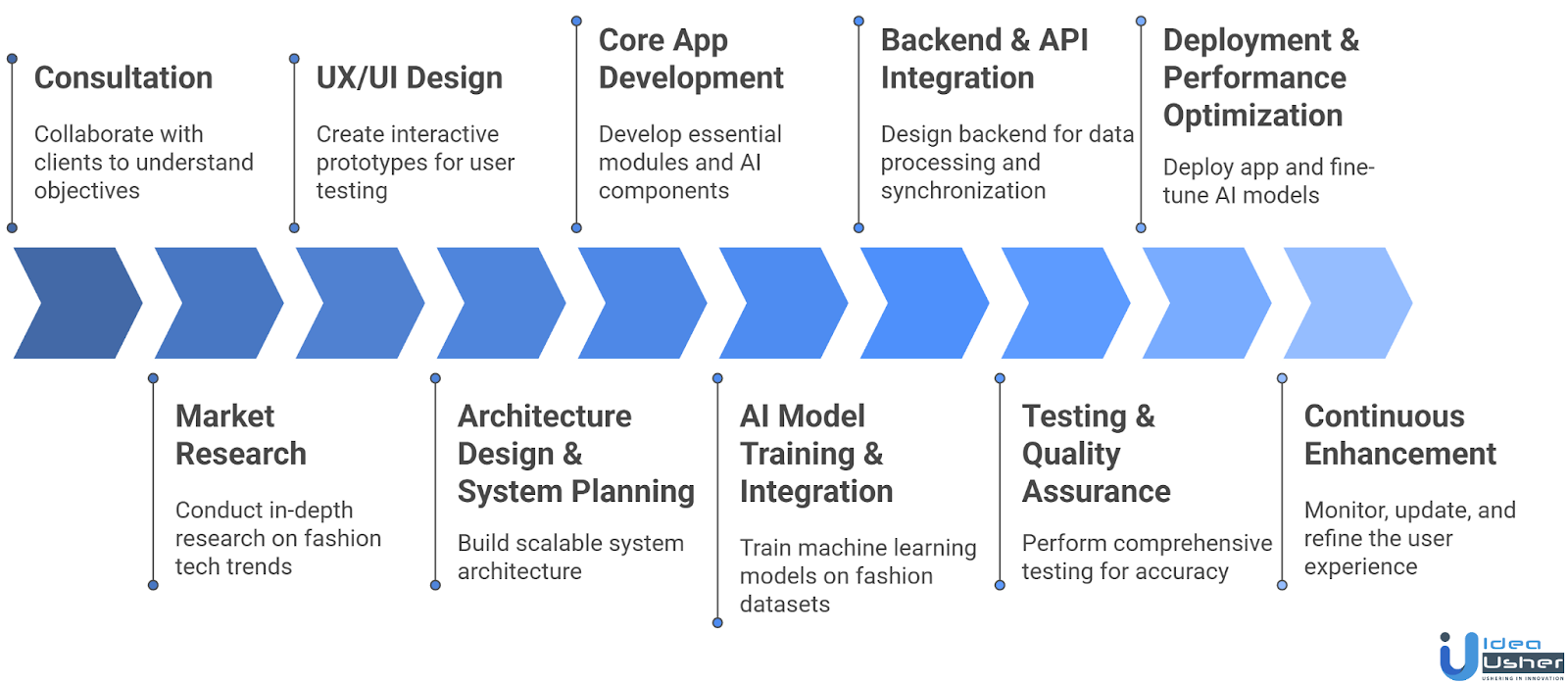
1. Consultation
We start by collaborating with clients to understand business objectives, target users, and the app’s vision. This includes identifying key challenges in outfit planning , wardrobe management, and fashion discovery. By clarifying requirements early, we ensure the app addresses real user needs and provides tangible value.
2. Market Research
Our team conducts in-depth research on fashion tech trends, competitor offerings, and user behavior. This helps uncover gaps in the market, identify trending features, and explore opportunities for AI-driven solutions like personalized styling, virtual try-ons, and trend prediction.
3. UX/UI Design
Design focuses on simplicity, elegance, and ease of use. We create interactive prototypes for digital wardrobe management, AI-powered outfit suggestions, and weekly planning tools. Prototypes allow early testing of user flows, visual appeal, and engagement, ensuring a smooth user experience before development begins.
4. Architecture Design & System Planning
We build a scalable and modular system architecture capable of managing wardrobe data, AI computations, and integrations with third-party services. This stage ensures seamless AI functionality, real-time outfit recommendations, and smooth synchronization across devices.
5. Core App Development
Development covers the creation of essential modules, including:
- Digital wardrobe cataloging
- AI-powered outfit recommendation engine
- Virtual try-on and AR styling
- Weekly outfit planner and personalized suggestions
- Smart shopping assistant
- Color harmony analysis
AI components are embedded to provide predictive styling, personalized recommendations, and trend analytics, delivering a highly interactive fashion experience.
6. AI Model Training & Integration
We train machine learning models on diverse fashion datasets covering styles, body types, occasions, and trends. This ensures accurate color harmony detection, outfit recommendations, and trend forecasting personalized to each user’s preferences.
7. Backend & API Integration
The backend is designed to manage user profiles, wardrobe databases, AI processing, and third-party integrations such as e-commerce platforms or AR modules. APIs enable real-time data processing, seamless synchronization, and scalable performance.
8. Testing & Quality Assurance
Comprehensive testing is performed to validate AI recommendations, virtual try-on accuracy, and app functionality. We test across devices and user scenarios to ensure consistent performance, usability, and reliability.
9. Deployment & Performance Optimization
The app is deployed on a robust cloud infrastructure with scalability in mind. Post-launch, AI models are continuously fine-tuned using user interaction data to improve recommendation accuracy, trend analysis, and overall user engagement.
10. Continuous Enhancement
Ongoing support includes monitoring, retraining AI models, updating features, and refining the user experience. This iterative process ensures the app evolves alongside fashion trends and user expectations, keeping it relevant and highly engaging.
Cost to Build a Style Analyzer App like ChicAI
Building a style analyzer app like ChicAI combines AI-powered fashion recommendations with a seamless user experience. The cost depends on features, AI complexity, platform choice, and design requirements.
| Development Phase | Description | Estimated Cost |
| Consultation | Initial discussions to define app goals, target audience, and technical requirements before starting design and development. | $3,000 – $5,000 |
| Market Research | Competitor analysis and trend research to understand user preferences, fashion trends, and app differentiation opportunities. | $4,000 – $7,000 |
| UI/UX Design | Creating intuitive, visually appealing, and user-friendly interfaces for seamless style analysis experiences. | $7,000 – $11,000 |
| System Architecture | Designing scalable and secure technical architecture for the app, including cloud infrastructure and data management strategies. | $6,000 – $10,000 |
| AI Model Training & Integration | Developing and training AI models for style detection, outfit recommendations, and personalization using machine learning techniques. | $17,000 – $30,000 |
| Core Feature Development | Implementing essential features like wardrobe analysis, style scoring, and fashion recommendation engines. | $14,000 – $23,000 |
| Backend & API Integration | Integrating backend systems, third-party APIs, and databases for real-time analysis and seamless app functionality. | $15,000 – $27,000 |
| Testing | Conducting rigorous testing including performance, usability, and security to ensure smooth app operation. | $5,000 – $8,000 |
| Deployment & Optimization | Setting up production servers, cloud hosting, and optimizing app performance for public release. | $4,000 – $7,000 |
| Continuous Improvement | Ongoing updates, AI model improvements, and feature enhancements based on user feedback and evolving fashion trends. | $6,000 – $12,000 |
Total Estimated Cost: $60,000 – $120,000
Note: This is an estimated cost breakdown to provide clarity on the investment required for building a Style Analyzer App like ChicAI.
Consult with IdeaUsher for tailored guidance, development strategies, and pricing based on your specific app requirements.

Cost-Affecting Factors to Keep in Mind
When planning a style analyzer app, several factors can influence the overall development cost. Understanding these elements helps businesses budget effectively and make informed decisions without compromising on quality or functionality.
1. Complexity of AI Models
The sophistication of AI models for style detection, outfit recommendations, and personalization directly affects development time and cost. More advanced AI requires higher investment in training and testing.
2. Number of Features
Adding features like wardrobe management, trend analysis, social sharing, and virtual try-ons increases both development and maintenance costs. Core features are more cost-efficient during MVP development.
3. Platform Choice
Developing for multiple platforms (iOS, Android, Web) increases costs compared to a single-platform launch. Cross-platform frameworks can reduce cost but may limit customization.
4. Integration with Third-Party Services
APIs for image recognition, fashion databases, or e-commerce platforms add complexity and licensing costs, influencing the overall project budget.
5. Maintenance & AI Model Updates
Regular AI model retraining, app updates, and feature enhancements contribute to ongoing costs after the initial launch. A scalable architecture can optimize long-term investment.
Challenges & How to Overcome Those?
Creating a style analyzer app like ChicAI involves unique challenges in fashion, AI, and user experience. Addressing these effectively ensures accurate, personalized, and engaging recommendations. Below is a breakdown of key challenges and how we plan to address them.
1. Accurate Fashion Recognition
Challenge: Ensuring the AI accurately identifies clothing types, colors, patterns, and textures in diverse images is difficult, as users upload varied quality photos and styles.
Solution: We train the AI models using large, diverse, and annotated fashion datasets, continuously incorporating user-uploaded images to refine recognition, ensuring the app adapts and improves fashion understanding over time.
2. Personalization & User Preference Modeling
Challenge: Delivering truly personalized outfit suggestions requires understanding individual style, body type, occasion, and evolving fashion preferences, which is complex and dynamic.
Solution: Our approach uses advanced recommendation algorithms that learn from user behavior, feedback, and wardrobe uploads, refining outfit suggestions dynamically to match each user’s unique style profile accurately.
3. Virtual Try-On Precision
Challenge: AR-based virtual try-on must accurately represent clothing fit, body proportions, layering, and movement, or users may experience unrealistic visualizations.
Solution: We integrate robust computer vision and AR frameworks, while allowing manual adjustments for size, posture, and camera angles, giving users a realistic virtual try-on experience for every clothing item.
4. Trend Forecasting & Style Relevance
Challenge: Keeping the app updated with global fashion trends and predicting styles that suit individual users is challenging due to constantly changing trends.
Solution: We continuously analyze social media, fashion blogs, and influencer content, combining AI trend prediction with personalization, ensuring recommended pieces are always stylish, relevant, and aligned with each user’s taste.
Conclusion
Creating a style analysis platform that mirrors ChicAI involves more than just AI integration; it’s about building an experience that understands individual preferences and elevates personal styling. With the right approach to design, data, and personalization, Style Analyzer App like ChicAI Development can help fashion startups and brands redefine how users discover and refine their looks. As AI-driven personalization continues to grow in fashion tech, investing in such a platform can position your business as a leader in intelligent style innovation.
Why Choose IdeaUsher for Your Style Analyzer App Development?
At IdeaUsher, we specialize in building AI-driven fashion apps that help users discover personalized styles effortlessly. Whether your goal is to launch a style analyzer, virtual try-on tool, or fashion recommendation platform, we provide end-to-end solutions tailored to your vision.
Why Work with Us?
- AI & Fashion Tech Expertise: Our team leverages advanced AI and machine learning to create apps that offer accurate style recommendations.
- Custom Solutions: From concept to deployment, we craft apps that reflect your brand’s unique approach to fashion.
- Proven Success: With experience in AI and lifestyle app development, we deliver high-quality solutions that engage users and drive retention.
- Scalable & Secure: We build apps that grow with your user base while ensuring top-notch security.
Take a look at our portfolio to see how we have partnered with clients to create effective AI solutions.
Discover how we can help you create a style analyzer app that transforms the way users experience fashion. Get in touch today for a free consultation!
Work with Ex-MAANG developers to build next-gen apps schedule your consultation now
FAQs
A Style Analyzer App like ChicAI should include personalized style recommendations, outfit suggestions, AI-driven visual recognition, wardrobe organization, and user behavior tracking. These features ensure the app delivers a tailored fashion experience that adapts to individual preferences.
AI analyzes user preferences, past interactions, and style trends to provide customized outfit suggestions. Machine learning models continuously learn from user behavior, improving recommendation accuracy and making the app increasingly tailored over time.
The development cost depends on app complexity, features, and platform. A basic style analyzer app may start around $60,000, while advanced AI-driven solutions with personalization and analytics can exceed $120,000 or more.
Yes, integration with e-commerce platforms allows users to buy recommended outfits directly through the app, enhancing convenience and engagement. APIs from fashion retailers can be used to sync inventory and product details in real time.
